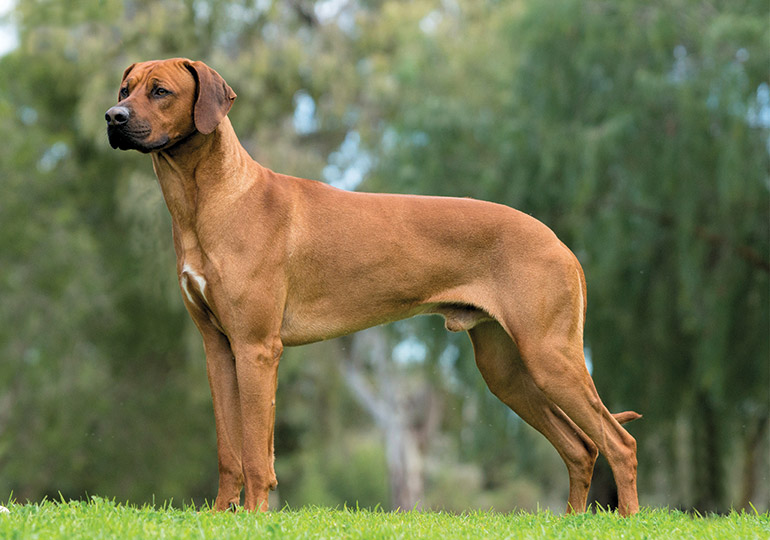Breeds
Rhodesian Ridgeback

Group 4 - Hounds
History
The Rhodesian Ridgeback was first bred in South Africa. A man made breed, several breeds were selectively chosen to make the Rhodesian Ridgeback, to suit the needs of the hunters in the 1900s. Although it cannot be categorically proven, it is thought the breed got its ridge from the wild ridged dog the (Hottentot) of the Khoikhoi tribe in the Kalahari. They wanted a dog that was strong and courageous, short coated, good at tracking game and hunting, and a gentle guardian for their families.
Another name given to this breed was the “Lion Dog,” as it was used for hunting lions.
The standard for the Rhodesian Ridgeback was drawn up in 1922 in Rhodesia, thus being given the name Rhodesian Ridgeback. It was first registered by the South Africa Kennel Club in 1924 and introduced to America in 1955. The first Ridgeback to come to Australia was in 1966.
Appearance
The Rhodesian Ridgeback is a strong, handsome, muscular dog with a short gold / tan coat (colour described as wheaten). There is a ridge of hair growing in the opposite direction to the rest of the coat along its back, starting at the shoulder blades, where it has two crowns or whorls, and continuing to the hips, which is how the breed got it’s name. Desirable height for males is 63-69cm and females 61-66cm.
Temperament
The Rhodesian Ridgeback has a quiet laid back demeanour, rarely barking unless they are warning their owner of a stranger, or danger is approaching. They will spend many hours of the day stretched out in the sun in summer, or in front of the fire in winter, but always never far from their owner.
It should be kept in mind the Ridgeback was developed as a dual purpose dog. He was needed as a hunter and a field dog, but also a house dog and gentle guardian to the family. More people each year are discovering the Rhodesian Ridgeback’s gentle temperament, affectionate nature and their desire for human companionship. This has made the breed particularly desirable as a pet for families with children.
Health
Ridgebacks like most breeds have some health conditions. While not prominent in the breed, hip and elbow dysplasia has appeared from time to time. Reputable breeders are very conscientious about screening and x-ray their breeding stock.
The other congenital defect is called Dermoid Sinus. Dermoid Sinus is a narrow tube like structure, which penetrates from the skins surface downwards into muscles towards the spinal cord where it forms a cyst.
Found anywhere along the length of the spine. The incidence is not entirely clear. Experienced breeders can detect this condition at birth. In general the Rhodesian Ridgeback is a very hardy breed and will only need visit the vet for their yearly vaccinations and health check. Average life span is 10 – 12 years but many have reached the age of 15 years.
Maintenance
The Rhodesian Ridgeback requires relatively low maintenance. Due to its short sleek coat, grooming consists of a weekly brushing. The Ridgeback does require some exercise and, as this is a fast growing breed, needs to be very easy for the first 12 months. After this time you can go running with your dog freely.
Suitability
This breed is suitable for all types of families. Is very good with children. The Ridgeback can be wilful at times so needs a firm owner to show them their place within the pack (family).
Words: Terry Shield
Image supplied by Rebecca Lamb and taken by Mark & Josie Haseldine
In Conclusion
Now you know a little about the Rhodesian Ridgeback you may have think that this is the dog for you. Before you make a decision, please make contact with the breed club or your State controlling body for purebred dogs. They will be able to give you information about available puppies and also suggest dog shows where you can see the breed and speak to breeders. In this way you will gain a better perspective of the Rhodesian Ridgeback and its needs and whether this breed would suit your lifestyle.
Breeders






